Spring Bear Hunting Tips
By Paul Tunkis
Big game season here in Montana generally ends the last Sunday in November, and so begins my nearly five month wait for spring bear to open. Coyote hunting over the winter helps keep me in shape and spring gopher hunting is something I've looked forward to most of my life, but it's not the same as big game hunting. By April and May I'm ready to look for something larger and more interesting. Bears have the added excitement of going after dangerous game. Granted that might be a stretch, but it's about as good as it gets outside Africa or Alaska.
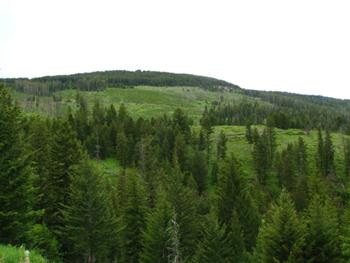
Clear-cut overlooking access road and forest area.
The standard advice on western bear hunting is to hike around and glass likely areas. The givers of advice then go on to describe the general topography, meadows, old clear-cuts or burned areas and add some discussion on rifles and the like. There are some basic questions that often go unanswered, the most important of which is "If I don't actually see a bear, how do I know if the area I'm hunting has any bear frequenting it?"
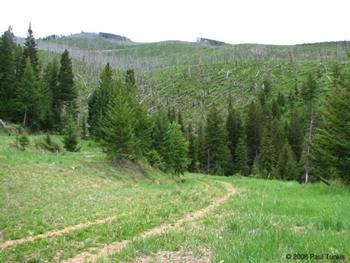
Access road leading to clear-cut and burned area.
The advice about old clear-cuts and burns is a very good place to start; the last two bears I've killed have been near just those types of terrain. Bears like roads and trails and I always walk all the roads in my prospective hunting area first. After I've walked the roads I start on any heavily used trials I find that might intersect those roads. So besides a live bear what do I look for? Bear tracks are notoriously difficult to spot because of their soft paws so I pay very close attention to any wet areas, such as where a seep spring comes across a road or trail. Bears will often stop to drink at those spots and will leave tracks. If you find a track in a wet area examine the area very carefully, never step on the tracks and look for other indications of bear activity nearby. Has the bear rubbed off some hair on a tree? How about scat? Is it fresh?
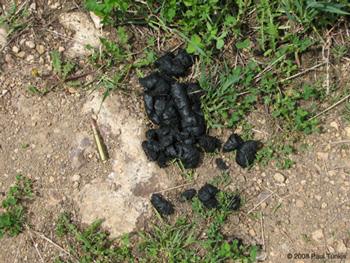
A 35 Whelen round gives a rough idea of size. This scat is composed entirely of grass and plant material. It was found on a open road bed that get only afternoon sun, though black it was still soft, perhaps only a day or two old.
In one area I hunted a few years ago a bear had left 17 piles of scat on an old logging road over a distance of about a mile and a half. The age of the scat ranged from a few hours to over a week. It's very difficult to make any hard and fast rules about how old bear scat is because of the nature of late spring weather and the location of the scat relative to sun exposure. A reasonable generalization is if the scat is black it's been there a while. Bears eat large amounts of green vegetation in the spring and if the scat you find is some shade of green and still soft you've found an area where a bear has been recently, probably that day or even within a few hours. If it still feels warm, granted that might be a bit over the top for some folks, even better. I guess you could say that if you push it around and it steams a bit you've found bear hunting gold.
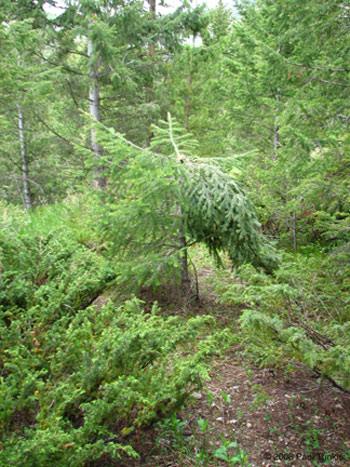
Freshly chewed off tree on overgrown logging road.
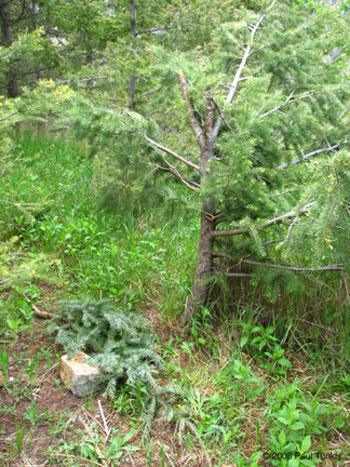
A bear completely tore the top off this tree. If you look closely you'll see that this is the second time the tree has been "topped". When I moved the tree top on the ground I found that the bear had flipped the rock over to look for insects.
If you've found tracks and some scat you can look for some other sign that will give you a hint if the bear in your hunting area is a boar or a sow. Male bears like to leave "calling cards" for other bears, male and female, in the area that they are moving through during the spring mating season. One of the most interesting of these is the "topped tree". I've found more of these on old logging roads than anywhere else but I think that the bear is leaving these where it knows other bears will see it. As you can see in the accompanying photos the tree of choice is a young evergreen about 6 to 8 feet in height and about one to two inches in diameter at the point the bear chews it off. I think it's a safe assumption that the height at which the bear chews the top off is about head height when it is standing on its hind legs. Most of the ones I've found were topped about four and a half to five and a half feet off the ground. A tree chewed off six feet or more off the ground would be a great indication of a very large bear in the area. I've also found areas with larger trees that have been chewed on but not broken off as well. Large trees with partially healed bite marks or small trees with dead tops can be an excellent indicator that the area you've found is frequented every year by the same or several boar bears looking for love.
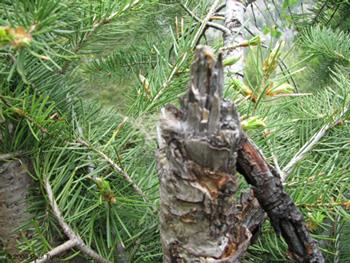
A bear chewed on the stump from the last time it or some other bear chewed off the tree top.
Article Tools
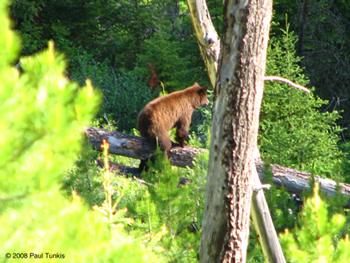
This bear appears to present a perfect shot. If you take your time as you should you'll notice the small black shadow directly under the bear. In a few moments it will move revealing itself to be the sow bear's new cub.
I now had a choice, either climb higher up the slope to find a place to sit and glass the open area or still hunt the black timber and jack pines. Since it was getting to lunch time I opted for the glass and eat lunch option.
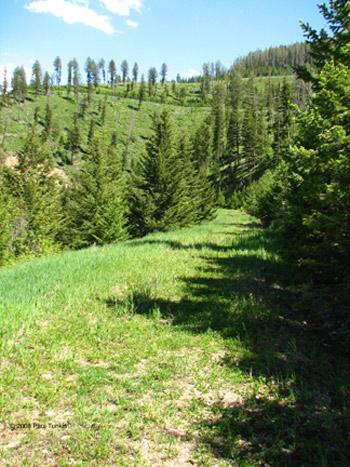
This unused logging road provides bears with a perfect spring feeding area. Flat easy walking, lots of fresh green grass and forbs and water where the road crosses any spring run off streams makes for an ideal area to look for fresh bear sign.
A good glassing location is a ridge in the middle of a burn or clear-cut. If a road bisects the ridge line even better. You want to be able to see as much ground as possible. Even if you are overlooking a square mile or more of ground, remember you are most likely only going to see one bear. Don't be too concerned about being spotted. Bears are nearsighted and spend quite a bit of time concentrating on what is just in front of them. The wind is everything. They may not see you but they will smell you every time. There is no such thing as "scent control" clothing or anything else when it comes to bears. If two molecules of your scent path cross a bear's nose, the bear will know your age, weight, what brand of detergent you washed your socks in and will likely begin putting some serious distance between you and him. If you were ambitious enough and hiked to the top of the cut or burn you will most likely see the bear below you, and getting within 300 to 500 yards should be simple enough. In burns and cuts it is often easier to make a cross canyon shot than it is a shot at the bear from the same slope. If you just can't get off the slope the bear is on, you may end up with a shot measured in feet rather than yards.
If you do make a nice cross-canyon shot, it's a real help to have a hunting partner guide you to your trophy, since the low thick brush in these areas can make finding a downed bear very difficult. If you are alone, tie a few lengths of bright surveyor's ribbon to the brush near where you shot from. Now take out your GPS unit and mark that spot, play attention to the elevation, was the bear above you or below you? Mark the downed animal's direction from your shooting spot as best you can. If you have fair idea of the elevation you can do a back azimuth to your shooting spot and at least get you close to the downed bear.
Take your time; it is very important when hunting bears in the springtime to never shoot on sight. Bear cubs, especially in the spring when they first emerge from the natal den are small and easily missed. Shooting a sow with cubs is illegal everywhere I am aware of and totally unethical. You also need to check to see what kind of shape the bear's hide is in; a big hairless patch on a hide makes for a poor trophy.
What happened with the bear I followed up the mountain? Well, that story ended at 20 feet so I guess it's not a good story for Long Range Hunting…
By Paul Tunkis
Big game season here in Montana generally ends the last Sunday in November, and so begins my nearly five month wait for spring bear to open. Coyote hunting over the winter helps keep me in shape and spring gopher hunting is something I've looked forward to most of my life, but it's not the same as big game hunting. By April and May I'm ready to look for something larger and more interesting. Bears have the added excitement of going after dangerous game. Granted that might be a stretch, but it's about as good as it gets outside Africa or Alaska.

Clear-cut overlooking access road and forest area.
The standard advice on western bear hunting is to hike around and glass likely areas. The givers of advice then go on to describe the general topography, meadows, old clear-cuts or burned areas and add some discussion on rifles and the like. There are some basic questions that often go unanswered, the most important of which is "If I don't actually see a bear, how do I know if the area I'm hunting has any bear frequenting it?"

Access road leading to clear-cut and burned area.
The advice about old clear-cuts and burns is a very good place to start; the last two bears I've killed have been near just those types of terrain. Bears like roads and trails and I always walk all the roads in my prospective hunting area first. After I've walked the roads I start on any heavily used trials I find that might intersect those roads. So besides a live bear what do I look for? Bear tracks are notoriously difficult to spot because of their soft paws so I pay very close attention to any wet areas, such as where a seep spring comes across a road or trail. Bears will often stop to drink at those spots and will leave tracks. If you find a track in a wet area examine the area very carefully, never step on the tracks and look for other indications of bear activity nearby. Has the bear rubbed off some hair on a tree? How about scat? Is it fresh?

A 35 Whelen round gives a rough idea of size. This scat is composed entirely of grass and plant material. It was found on a open road bed that get only afternoon sun, though black it was still soft, perhaps only a day or two old.
In one area I hunted a few years ago a bear had left 17 piles of scat on an old logging road over a distance of about a mile and a half. The age of the scat ranged from a few hours to over a week. It's very difficult to make any hard and fast rules about how old bear scat is because of the nature of late spring weather and the location of the scat relative to sun exposure. A reasonable generalization is if the scat is black it's been there a while. Bears eat large amounts of green vegetation in the spring and if the scat you find is some shade of green and still soft you've found an area where a bear has been recently, probably that day or even within a few hours. If it still feels warm, granted that might be a bit over the top for some folks, even better. I guess you could say that if you push it around and it steams a bit you've found bear hunting gold.

Freshly chewed off tree on overgrown logging road.

A bear completely tore the top off this tree. If you look closely you'll see that this is the second time the tree has been "topped". When I moved the tree top on the ground I found that the bear had flipped the rock over to look for insects.
If you've found tracks and some scat you can look for some other sign that will give you a hint if the bear in your hunting area is a boar or a sow. Male bears like to leave "calling cards" for other bears, male and female, in the area that they are moving through during the spring mating season. One of the most interesting of these is the "topped tree". I've found more of these on old logging roads than anywhere else but I think that the bear is leaving these where it knows other bears will see it. As you can see in the accompanying photos the tree of choice is a young evergreen about 6 to 8 feet in height and about one to two inches in diameter at the point the bear chews it off. I think it's a safe assumption that the height at which the bear chews the top off is about head height when it is standing on its hind legs. Most of the ones I've found were topped about four and a half to five and a half feet off the ground. A tree chewed off six feet or more off the ground would be a great indication of a very large bear in the area. I've also found areas with larger trees that have been chewed on but not broken off as well. Large trees with partially healed bite marks or small trees with dead tops can be an excellent indicator that the area you've found is frequented every year by the same or several boar bears looking for love.

A bear chewed on the stump from the last time it or some other bear chewed off the tree top.
Article Tools
- Scratching trees are also important. Bears mark territory with this behavior and generally use larger trees than those that they top off. It's also common for these trees to have bite marks on them, especially in the springtime, serving the same purpose as the smaller topped trees. You will often see where the bear has bitten off some of the bark or chewed deeply into the tree trunk itself. Conifer trees will ooze lots of sticky sap after being torn up by a bear and you will sometimes find bear hair stuck to the tree. This also happens with the topped trees. I've been able to determine what color bear made the marks in an area on several occasions. Look for "bear trees" next to trails, or roads. I think that there is some significance to the location of these trees; at least I've found some that I think I know what the bear was up to. I've found these types of trees near a ridge pass from one drainage to another and in areas that have a repeatable food source such as berries or a spring pasture with a wide variety of greenery. These signposts could be a mark of ownership of a territory. I've also found them in campgrounds; maybe the bear is trying to tell us something. In one of my favorite campgrounds there are claw marks eight to nine feet up an eighteen inch diameter fir tree; this area is also home to a very large boar grizzly.
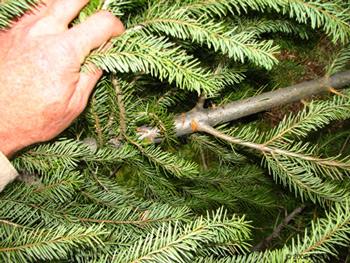
Tooth marks on freshly chewed off tree top.
The height off the ground, size, shape and depth of the claw marks can also tell you something about the bear that made them. Height off the ground is the most obvious, bears will reach up at least head high to scratch a tree so scratches six feet up can indicate a bear of over 250 pounds. Next put your hand up to compare the spread of the claw marks, remember bears don't have a thumb like primates, so all five claws will form the mark. If you have to spread your hand out to cover all the claw marks things are looking good. Black bears have climbing claws, short, curved and sharp; grizzlies have digging claws, long, straight and blunt compared to a black bear. The scratch marks of a black bear will look like deep cuts in the bark; grizzly marks will remove a wider strip of bark exposing the cambium layer and are not as deep.
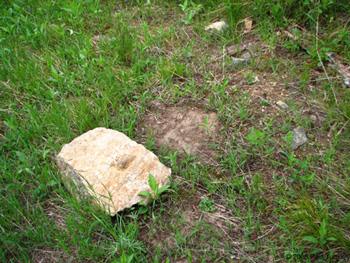
Bears will often flip over stones to look for insects.
A bear hunt from a few years ago is a good example of how all this information can be put to good use. The old logging roads in the area I was hunting had been closed off, a loss of access for motorized users but a boon to spring bear hunting. The area is a mixture of clear-cuts, selective cuts and an old burn. As I climbed higher up the road I found some bear scat. It was black but still soft indicating that a bear had been in the area recently. Just below a large clear-cut a small spur road cut across the face of the mountain. This road was overgrown and there were many small trees growing in the road bed. I'd found "topped trees" on this road in prior years so it seemed like a good place to start looking.
With a light breeze in my face I began to slowly walk the road. A few hundred yards along I found a freshly topped tree. The top broken section about five feet from the ground was still green and fresh, the sap runny and very sticky; a few cinnamon colored hairs were stuck in the sap. A little further along I found where a small seasonal creek had flooded over the road, there were bear tracks going in the same direction I was traveling in which was encouraging. The tracks were a bit wider than my own hand, a rough indication that the bear was an adult between 150 and 250 pounds.
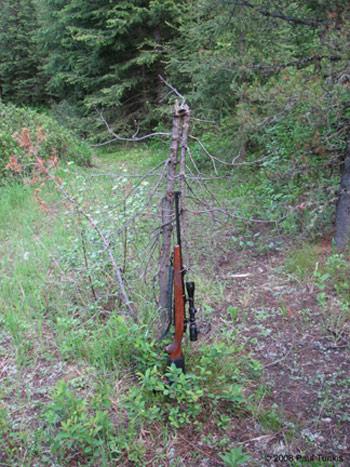
This tree on an old logging track has been killed by a bear. Finding areas with both fresh and old dead trees indicates that this is an excellent area to search for more sign and a good trophy.
Since I knew I was following a bear, I was not only extremely alert to bumping into my quarry, but I'd also begun to search diligently for even the smallest sign of its passing. I'd set the length of my adjustable hiking staff for the bear's track length and used it to pace out the bears tracks. This is very useful when tracking a soft footed animal since you will often lose the track, and if you can accurately pace it out it's surprising how easy it is to find it again. After about a mile I found the bear's track on an elk trail leaving the road and heading uphill. The trail was loose and soft and the bear's tracks obvious.
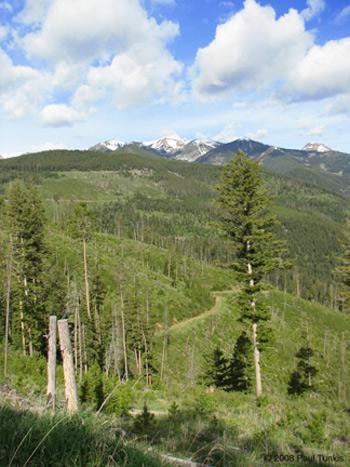
This view shows the variety of habitat that bears find very attractive in the spring time.

This bear appears to present a perfect shot. If you take your time as you should you'll notice the small black shadow directly under the bear. In a few moments it will move revealing itself to be the sow bear's new cub.
I now had a choice, either climb higher up the slope to find a place to sit and glass the open area or still hunt the black timber and jack pines. Since it was getting to lunch time I opted for the glass and eat lunch option.

This unused logging road provides bears with a perfect spring feeding area. Flat easy walking, lots of fresh green grass and forbs and water where the road crosses any spring run off streams makes for an ideal area to look for fresh bear sign.
A good glassing location is a ridge in the middle of a burn or clear-cut. If a road bisects the ridge line even better. You want to be able to see as much ground as possible. Even if you are overlooking a square mile or more of ground, remember you are most likely only going to see one bear. Don't be too concerned about being spotted. Bears are nearsighted and spend quite a bit of time concentrating on what is just in front of them. The wind is everything. They may not see you but they will smell you every time. There is no such thing as "scent control" clothing or anything else when it comes to bears. If two molecules of your scent path cross a bear's nose, the bear will know your age, weight, what brand of detergent you washed your socks in and will likely begin putting some serious distance between you and him. If you were ambitious enough and hiked to the top of the cut or burn you will most likely see the bear below you, and getting within 300 to 500 yards should be simple enough. In burns and cuts it is often easier to make a cross canyon shot than it is a shot at the bear from the same slope. If you just can't get off the slope the bear is on, you may end up with a shot measured in feet rather than yards.
If you do make a nice cross-canyon shot, it's a real help to have a hunting partner guide you to your trophy, since the low thick brush in these areas can make finding a downed bear very difficult. If you are alone, tie a few lengths of bright surveyor's ribbon to the brush near where you shot from. Now take out your GPS unit and mark that spot, play attention to the elevation, was the bear above you or below you? Mark the downed animal's direction from your shooting spot as best you can. If you have fair idea of the elevation you can do a back azimuth to your shooting spot and at least get you close to the downed bear.
Take your time; it is very important when hunting bears in the springtime to never shoot on sight. Bear cubs, especially in the spring when they first emerge from the natal den are small and easily missed. Shooting a sow with cubs is illegal everywhere I am aware of and totally unethical. You also need to check to see what kind of shape the bear's hide is in; a big hairless patch on a hide makes for a poor trophy.
What happened with the bear I followed up the mountain? Well, that story ended at 20 feet so I guess it's not a good story for Long Range Hunting…

